Not Sure if Meme or Artform
The Beginnings of the Meme
The purpose of this work is to discuss digital artwork, specifically focusing on Internet memes, and discussing their legitimacy in the world of art. A meme (as to what a meme is, I will discuss in depth later) is but one of the byproducts of social media on the Internet. With the creation of digital photography and image editing software like Photoshop, the methods of producing art have expanded into the digital realm. Through image sharing via the Internet, people have more access to study, be 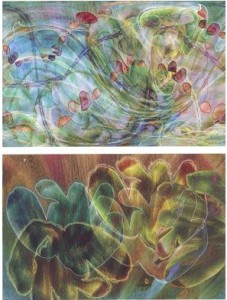 inspired by, and to create their own works of art. “In art, visual literacy is no longer limited to ‘the object.’ It must embrace the fluid, ever-changing universe that exists inside the computer and the new world the computer facilitates: an interactive art world that can be virtual in its reality and radically interdependent on its incorporation of ‘the viewer’ into the completion of the work of art.”[1]
inspired by, and to create their own works of art. “In art, visual literacy is no longer limited to ‘the object.’ It must embrace the fluid, ever-changing universe that exists inside the computer and the new world the computer facilitates: an interactive art world that can be virtual in its reality and radically interdependent on its incorporation of ‘the viewer’ into the completion of the work of art.”[1]
Digital artwork is incredibly popular in certain forms. Software like Photoshop is used to edit photographs and create digital paintings, and it is used for graphic design and many other applications as well. While the medium of digital art is significantly different from that of “traditional art,” the creative process is identical. Apart from the change in medium, the other significant difference in digital art is that it allows for more experimentation by artists.
Similar to the printing press, Photoshop allows artists to create an infinite number of works from a single original drawing or file. The two works shown above[2], by JD Jarvis, are two digital paintings which both originated from the same file. By saving a file under two different names, the artist can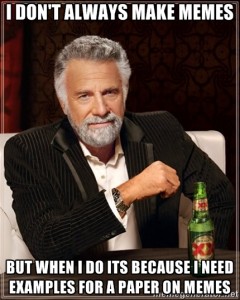 explore different pathways and create different final products from the same initial starting place. In Jarvis’ work, he clearly explores two very different paths. Through experimentation and different creative decisions he arrived at two very different pieces of art. Software like Photoshop has allowed artists to expand their ideas and create different works of art from the same inspiration. Since these works of art are created on computers, this has also allowed for easier sharing of work. The Internet has created an environment where images can be shared, and where popular works of art can quickly “go viral” through social media. The ability to share popular images and to slightly alter another person’s image, or create a similar image with Photoshop is the foundation that led to the popularity of Internet memes.
explore different pathways and create different final products from the same initial starting place. In Jarvis’ work, he clearly explores two very different paths. Through experimentation and different creative decisions he arrived at two very different pieces of art. Software like Photoshop has allowed artists to expand their ideas and create different works of art from the same inspiration. Since these works of art are created on computers, this has also allowed for easier sharing of work. The Internet has created an environment where images can be shared, and where popular works of art can quickly “go viral” through social media. The ability to share popular images and to slightly alter another person’s image, or create a similar image with Photoshop is the foundation that led to the popularity of Internet memes.
The Internet Meme
So what exactly is a meme? For starters, the image on this page (recognizable as “The most interesting man in the world” from a popular beer commercial) is one example of a meme. There are many different types of memes, but let us start with the basics. In the age of the Internet it seems only fitting to conduct a Google search for the definition of the word meme. According to the popular search engine, meme is defined as: “An element of a culture or system of behavior that may be considered to be passed from one individual to another by nongenetic means, especially imitation.” [3]This is the classical definition for a word that has been used for centuries. In the age of the Internet and social media however, a different definition could be given for the word meme: “A humorous image, video, piece of text, etc. that is copied (often with slight variations) and spread rapidly by Internet users.” [4]This is the most basic definition of an Internet meme, but this does not help explain how or why they are created.
Memes are ultimately a form of communicating ideas. Popular culture references, new or different ideas, and humor are all common themes of memes. Another significant quality that a meme must have is popularity. In order for it to spread like wildfire (as memes often do) they must have a large number of people that enjoyed it, and wished to share it with their friends. More importantly in this discussion, a successful meme must also inspire others to make their own version.
It seems that memes certainly are a cultural phenomenon, but I believe that they are absolutely an art form as well. The beauty of a meme is in the simplicity and how, with some practice with image editing software, any person can create their own version of a meme. Like painting or drawing, creating memes also requires creativity and imagination. With the ever increasing popularity of memes, there was a demand to increase the accessibility to create captioned images. Websites have been created entirely for this purpose.[5]
The process of creating a meme with one of these websites is certainly straight forward. It is because of the simplicity in creating a meme that there is debate on whether or not memes can be considered an art form. However, the same arguments that defend minimalist art can be used to defend memes. Let us consider how we talk about art and why we consider it valuable. Art is recognized as something valuable to society, that communicates an idea, and that in the process of creating the art, some kind of creative decision was made. “Artistic creation is not defined by the tools used to make art… True artistic creation is defined by the imagination of the artist.” [6][7]All of these can be seen in Internet memes. The society in which they are valuable can be considered to be an amalgamation of different social media websites. Many memes communicate humor, often through ridiculous looking images, clever captions, or a combination of the two. What seems like a simple form of art is actually quite complicated.
Meme Variations
Meme creation sites typically create the most basic form of meme, a captioned image. This type of meme is what has been shown in this paper so far. However, this is only the most basic type of meme. Individuals with greater experience with the visual arts and who possess Photoshop skills have proven themselves very capable of creating what could be considered artwork that has more similarities to more traditional work.
These types of memes, “advanced” memes as I’ll call them, share many similarities to other digital artwork. Consider the following comparison between a simple, captioned image meme one of these “advanced” memes. On the left is what is known as the “such doge” captioned meme. The image on the left is a work that was done and shared by an artist on the Internet. Now let us briefly analyze each image to explore the differences between these two types of memes.
The “such doge” captioned image consists of a single image as a background layer and a two-part caption overlaid on top. There are literally thousands of images on the Internet which could be considered very similar, the only difference being different captions. This meme is known to focus on humor, and can usually be identified by the picture of the shibe inu[8] and the poor grammar. The example of this meme shown below contains wording that is common to this meme, such as “very,” “such,” and “wow.” Words are a significant part of memes, and serve as identifiers.
The image on the right is an adaptation of the “such doge” meme. The artist used digital editing software (such as Photoshop) to combine two or more images. Here, the background landscape is combined with a semi-transparent “such doge” image. The increased complexity of this image over the captioned meme is very apparent. Clearly many more creative decisions were required by the artist during the process of creating this meme; choice of background, image placement, color filters, transparency levels, etc. However the image still has the same attributes as traditional memes. This work uses a classic meme, the “such doge” meme, in order to convey humor. This image was shared extensively on the internet.[9] A notable difference between the two images is that the right image does not contain any words. Rather than creating a traditional meme, the artist referenced one by using a recognizable image.
The memes that have been discussed so far have only been stagnant images, but there is an entire genrea of memes that rely on animation. Animated memes are even more difficult to create than advanced memes, and these memes exist exclusively on the internet as it is fairly difficult to show animation on printer paper. The key description of these types of memes is “animated” rather than “video” as they do not have sound accompanied video.
This type of meme hints at the origins of many memes. Many memes have photographs as backgrounds, but there are also many that have screenshots of videos as backgrounds. These are often from popular movies, TV shows, or “viral” YouTube videos. This emphasizes the focus that memes have on popular culture.
While there is a large amount of creativity involved in creating memes, there are some well established rules that should be considered when making memes. Since many of these memes are so well known, a pattern has been established to create a standard for each. The stricktest rules applied to memes often relate to wording and syntax. There is a time and place for every meme, and there are definitely times one should be used over another.
Since many memes come from popular culture references such as movies or TV shows, many of the wording expected for a particular meme comes from the origin of the picture. In the meme above, the background image comes from Fellowship of the Ring, the first Lord of the Rings movie. In this scene, the character states “One does not simply walk into Morder.” The meme thusly must begin with the phrase “One does not simply” and anything other than that is considered wrong. The origins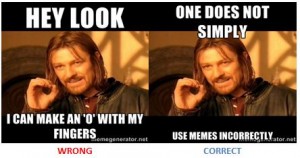 of the meme are incredibly important, and somone creating a meme must carefully choose which meme they wish to use, and the wording within the meme. While memes can be written incorrectly it is also possible to use the wrong meme, however this notion is more complicated and won’t be discussed further in this essay.
of the meme are incredibly important, and somone creating a meme must carefully choose which meme they wish to use, and the wording within the meme. While memes can be written incorrectly it is also possible to use the wrong meme, however this notion is more complicated and won’t be discussed further in this essay.
Popularity and Memes
When a particular meme becomes popular enough an unusual phenomenon occurs, it begins to have expectations set for it. That is, when confronted with a meme that you have seen many times before, you already have an idea as to what it is going to entail before even reading it. Let us consider some of the memes that I have mentioned so far. The meme on the title page is the “Not sure if” meme, which has its origins from the show Futurama[10]. Assuming the meme is used correctly, the reader/viewer of the meme already has an idea as to what to expect from this meme. Similar ideas come to mind when seeing a “Most Interesting Man in the World” meme. Some memes set even stronger expectations. The meme “Unpopular Opinion Puffin” is used to share an unpopular opinion.[11] When confronted with this meme, even before reading the words the viewer has some inherent idea of what to expect.
Memes become popular though a process that is not too dissimilar to a “mob mentality” of sorts. Sites like Reddit and Imgur (the image hosting site for Reddit) are but two of many websites that facilitate this process. Millions of people visit these sites every day and communicate with each other. When a meme generates enough popularity to become noticed on the front pages of these websites, a popularity explosion occurs as more people jump on the bandwagon. From here, many users will create their own versions of the meme by adding different captions or incorporating an aspect of it into their own, more unique art work.
The Internet meme, at face value seems fairly simple. What first seems to be a fun, “new” way of making jokes actually has quite a bit more substance. The creative decisions that are made when creating a meme need to tie together context and syntax. Artists who create more advanced memes consider these as well, and in referencing memes can communicate ideas without using words at all. Sharing memes through social media on the internet not only serves as a dialogue that communicates different ideas, but it also helps form communities on certain websites. People that enjoy similar things (ideas, humor, etc.) flock together to chat, create, and share their own images. When one thinks of digital artwork it is not uncommon to think of Photoshop and selling or sharing one’s work through the internet, but computers and the Internet have expanded artwork far beyond anything a single person could create. Memes are created by millions and can evolve and change. When significant current events or viral videos plaster social media sites, related memes are soon to follow as people begin to creatively think of new ways to share their thoughts through this visual aide. If social media sites are the newspapers of the Internet, memes are the comics and everyone turns to after they’ve skimmed the front page and gotten bored.
Bibliography
Ligon, S. 2010. Digital Art Revolution. Crown Publishing Group, New York.
Rush, M. 2005. New Media in Art. Thames & Hudson Ltd, London.
Signh, Gary, Poetry of Color, Computer Graphics and Applications, Volume 34, Issue 2, March 24 2014
Memes were creates using www.memegenerator.com
[1] Rush, M. 2005. New Media in Art. Thames & Hudson Ltd, London. Pg 183.
[2] Ligon, S. 2010. Digital Art Revolution. Crown Publishing Group, New York. Pg 16.
[3] Google.com – definitions. First definition of “meme”
[4] Google.com – definitions. Second definition of “meme”
[5] memegenerator.com
[6] Signh, Gary, Poetry of Color, Computer Graphics and Applications, Volume 34, Issue 2, March 24 2014
[8] A breed of dog, specifically the one shown in the “such doge” meme.
[9] Seen on http://imgur.com/gallery/JUC9VuG
[10] This is one instance where the character never actually says those words, but they still stuck to the meme
[11] Another unusual phenomenon occurs here, as in order for the instance of the meme to be popular the opinion can’t be too unpopular, or it wouldn’t be widely shared.
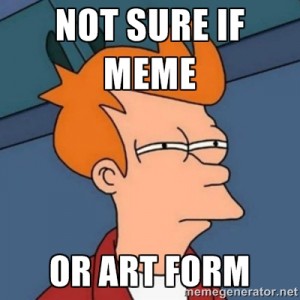
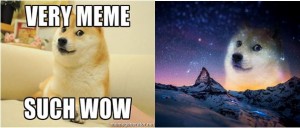
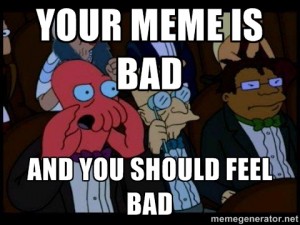
Leave a Reply